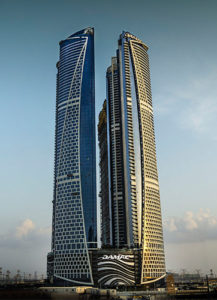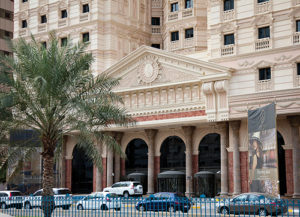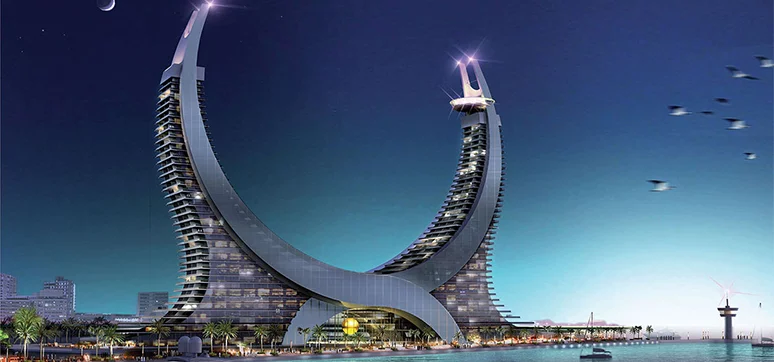Façade is one of the most crucial parts of a building and adds a visual outlook as an effect on the entire building’s design. A building façade has many layers to protect the exterior of the building, providing it sustainability, at the same time it’s identity. Façades should be aesthetically pleasing and its exclusivity is the requirement of the present era. Curtain wall and cladding are the integral part of a façade system. With the right choice of façade, by keeping in mind the materials’ durability, sustainability, compatibility and suitability, safety and availability, the look and lifespan of the entire building can be transformed. The right material gives a perfect façade.
For this cover story, we interviewed a few top names from the Middle-East’s façade industry to help our readers in choosing the best suitable solutions for their building façade requirements. The experts have also shared their views on the recent changes happening in the façade industry and their expectations for the coming years. So, here are some tips for picking the right façade materials and systems:
Parameters to be Considered While Deciding Type of Façades

Firstly, façade of a building depends on the design intent of the architect, which is often simply narrowed down to either an external capping or SG (structural glazing) joint between the glasses. Then, of course, we must understand key factors such as the structure, building movement, thermal, acoustics and performance specification requirements. With this information, we can decide on the most suitable types of façade to take into consideration, says Alastair Common, Technical Manager, Schüco Middle East Windows & Façade Systems LLC.
According to him, the other main factor would be the geometry of the building; often, we see buildings with unique designs and complex geometries. This must also be taken into consideration during the planning and implementation of the types of façades. Nikolas Mykoniatis, Operations Manager, ESC Aluminium Systems, explains that the key parameters for deciding the type of façade are the specifications that are received from the consultant, the design of the façade, the height of the building, and the budget of the project.

Jafar Haddadin, General Manager, ALUMAN Middle East, believes that the façade is the first thing that draws anyone’s attention to a building. The first impression does matter, as it affects and highly influences the overall image of the building.
Along with the architectural aesthetics and its local planning environment that might affect the building’s appearance, it is important to consider the interior function and the scale of the building in selecting the right type of façade in order to achieve specific energy efficiency and thermal comfort. one of the most important factors in selecting the type of façade is the financial investment in the project. Unfortunately, most of the stakeholders’ concern is the initial cost or the investment, which might be lower, but the maintenance cost and energy efficiency of the façade may afterwards be significantly high.
Parameters for Designing a Curtain Wall System for a Building

There are several parameters that should be considered while designing a curtain wall system for a building, observes Common, which include the architectural intent of the façade, wind pressure, and project specifications. Previous experience is crucial. Knowing which system to design, or not to design, is often based on previous experience. Testing is equally important. Implementing tried and tested systems will obviously help to ensure durability and sustainability. Engineering is Important to ensure that what is being designed is safe and fit for purpose. If a façade is not correctly engineered, then durability and sustainability will clearly be jeopardised.
Mykoniatis opines that when we start to design a new façade system for a building, we need to consider some basic factors. Some of them are the repeated variable wind loads and climatic conditions. These factors affect the long-term structural and infiltration performances of a façade.
According to Nikolas Mykoniatis, to ensure the sustainability of a curtain wall, we need to know a few basic rules:
• Aluminium extrusion must use alloy 6063 to BS EN 755–1 (60 years).
• For coating, we can have the following options-
– Anodising to BS 3987, minimum 25 microns thick, 30 years or more of service life.

– Polyester powder coating to BS 6496, minimum 40 microns thick, 5-25 years of service life
– Polyvinylidene fluoride (PVDF or PVF2) minimum 25 microns thick, 20 years or more of service life.
• The glass has an expected service life well in excess of 60 years.
• Gaskets and sealants are often the shortest-life components. Non-cellular EPDM gaskets to BS 4255 have an expected service life of 15 to 30 years or more. Sealants should comply with ISO 11600, with evidence from manufacturers for durability.
• A neutral cure-type silicone sealant has an expected service life of 5-20 years.
Haddadin believes that before designing a curtain wall system, there is a need to understand the three main functions of the curtain wall. The functions include weather barriers to prevent air infiltration and water penetration, building insulation (exterior to interior and between floors) against fire and smoke, thermal and acoustic, and the third one is light transmittance to the interior space.
Haddadin also mentions that along with these functions, we need to consider the physical loads imposed on the curtain wall such as wind loads, seismic and blast loads to ensure the durability and sustainability of the curtain wall. Other key factors that need to be considered when it comes to designing a curtain wall are the fabrication simplicity, the installation scheme, and the subsequent maintenance. Workmanship can enhance the performance of the curtain wall.
Criteria to Select Between Stick and Unitised Systems

In Common’s opinion, a stick curtain wall system is ideal where the building movement requirements are less stringent and would be appropriate for low to mid-rise projects. With stick systems, you also have considerably more work to do on-site, all the materials must be installed as individual pieces (mullions, transoms, spandrels, glass etc.), not to mention that external access is a must, whether it be via scaffolding, cradles, mast climbers etc. Whereas, unitised systems are more commonly implemented on high-rise towers where there will be higher levels of building movement. Unitised is also more suitable when the geometry is more regular and repetitive for panel optimisation. Furthermore, the unitised panels must be preassembled in the factory and delivered to the site. The panels can then be installed from inside the building in order to eliminate the need for external access.
Some basic criteria to select between a stick and a unitised system are the time (regarding the installation) and the height of the structure. Usually, stick systems take 3 times more installation time than unitised. Unitised system is well suited for cases where there is a requirement for a large volume of prefabricated panels. The unitised system is composed of large glass units that are created and glazed within a factory and then sent to construction.
It is more apt in the case of higher labour costs (thereby shifting the labour to a more cost-effective factory workforce), and where higher performance is needed (for wind loads, air permeability etc.) i.e., for taller structures, says Mykoniatis. If your project doesn’t suit the criteria for a unitised system, your other option is to use a stick system. Most low-rise structure buildings use stick curtain walls.
Haddadin too agrees that for low-rise buildings or buildings with small areas of installation where external access is easy, the stick curtain wall will be more cost-effective as it will lower the shipping cost and have minimal pre-fabrication, besides the lower material cost because of using fewer components. However, the long duration in the installation progress needs to be considered as well.
Aspects like high-quality pre-fabricated panels, the installation speed, and the ability to design the system to be installed without using the main crane are all advantages of a unitised system.
Aluminium – As an Efficient Curtain Wall Material

The early curtain walls were made with steel frames. Steel, however, is 3 times heavier than aluminium, and is far less flexible when it comes to designing. Aluminium, on the other hand, is an extremely flexible material due to the fact that it is lightweight, it can be easily extruded to almost any shape depending on the required design. The design complexity in the shapes of Aluminium profiles and its function is nearly unlimited. In regard to the finishes, almost any colour with different interesting types of finishes can be applied to aluminium, not to mention that it is a non-corrosive material by nature. Hence, aluminium is by far the most suitable material for curtain wall systems, and will remain to be so for many years to come, mentions Common.
Haddadin says, “With the price advantage and the design flexibility, aluminium is considered as one of the most preferred materials to be used in the curtain wall. Its lightweight and availability will reduce the overall cost of the building”. As a corrosion-resistant, durable and recyclable material, aluminium wins over other materials. Moreover, it is easy to apply and a variety of finishes, types and colours, make aluminium a leading curtain wall material.

Selection of Cladding Material
According to Mykoniatis, the criteria for the selection of cladding material is based on the design of the façade. Nowadays all the cladding material has high specs and the only limit is the imagination of the architect, he adds.
In addition to architectural aesthetics, building design, regulatory requirements, and all the other technical factors, it is important to consider a cost-effective material and its availability (for both the material itself and for skilled and experienced installers).
Moreover, the durability of the system, its compatibility with other cladding systems used in the same building and their maintenance requirements are also important factors to be considered in the design stage, explains Haddadin.
Factors Escalating the Performance of Façades

In Common’s view, the curtain wall has to be carefully studied during the design stage to take into consideration all of the performance criteria such as air and water tightness. The system must be designed to ensure that there is effective pressure equalisation and weatherproofing of the system. The façade must be Wind resistant and must be structurally sound which could be determined via calculations. While for the thermal and acoustic requirements, the combination of aluminium, glass, insulation, and other materials within the curtain wall must all be calculated together. All of the mentioned points can then be verified via thorough performance mock up testing to ensure that the curtain wall is fit for purpose.
Mykoniatis highlights a few factors, which are needed to achieve good performance for a façade system. The factors include the designing of an efficient profile, a correct water drainage system in order to achieve a good water penetration performance, efficient gaskets, and a well-designed connector (connection between the column and the transom). He believes that the correct combination of these factors can provide better performance.
For Haddadin, high performance in the construction sector is determined by energy efficiency during the operational stage. It depends on all the stages from design until the execution. The first step in the design stage is to understand the type of the building and it is functioning. The designer needs to study the building energy profile and determine the wall-to-window ratio while integrating the right sun shading devices if needed. Also, choosing the right material and façade system and all its components will have a great impact on the façade performance.
Haddadin adds that nowadays, most of the projects have a commissioning stage to safeguard its workmanship, durability and all the other environmental required performance. New technologies can be considered to enhance the performance of the building envelope, like the self-cleaning system, which reduces the operation and maintenance cost, and the night time natural ventilation system, which is applicable in the double skin façade, which can reduce the cooling loads of the building in the hot climate regions.
Latest Technologies in Curtain Wall Systems

Common noted that the trend is often to see less aluminium. “In recent years, we at Schüco, have developed and introduced into the market the slimmest system available with mullions and transoms only 35mm in face width. Also, another system with integrated/concealed vent within the system, in which any vent framing is not seen at the internal part, just only the line of mullion and transom are visible”, says Common.
According to Mykoniatis, solar technology for façade and glass systems are the latest technologies that all system suppliers are required to focus on. We must have “green” buildings, and we should be using thermal break profiles in order to “save” energy. Haddadin believes that the kinetic façade will be the future, where the curtain wall will be a non-static item. It will adopt to its surrounding climate and environmental conditions to manage light, air, and energy more efficiently.
Thermal Performance of Curtain Wall System
According to Common, thermal requirements are constantly increasing in the industry. “At Schüco, we have a huge array of systems which can accommodate from basic thermal requirements to super-insulated systems”, he says. It is very important not just to consider the thermal performance of the glass, but the curtain walls and the glass as a complete system. Especially in this region, thermal performance shows an important role and thus needs to calculate all the materials (aluminium, glass, insulation, back pans, etc.) to measure the rate of heat transfer based on the requirement in order to reduce the cooling load of the air conditioning.
Mykoniatis opines that aluminium is one of the primary framing materials of curtain walls. Curtain walls, however, also have problems, such as lesser thermal efficiency and moisture condensation, especially in countries where there are four seasons like Greece, because of wide glazing windows and metal frames that have high thermal conductivity.

Furthermore, insulation efficiency is more important in high-rise buildings than in low-rise buildings Nowadays we are using Low-e double glazing plus thermal isolators between the profiles (column/transom and pressure plate). These solutions reduce heat loss and prevent condensation in cold weather, or to minimise heat gain and air conditioning cost in hot weather. Haddadin mentions that the curtain wall industry has come a long way in improving the building envelope insulation throughout the year.
Back in the 1940s and 50s, double and triple-glazed insulating unites were prompted after the wide use of single-pane glass. With the inert gas or a vacuum seal between double-glazed panes and low-E coating glass, and by replacing the traditional aluminium spacer with the warm-edge spacer, the thermal performance of the curtain wall was significantly improved. Moreover, cutting-edge computer technology and thermal mock-up tests, makes reviewing the thermal performance of the façade easier.
On the other hand, a higher level of insulation requirements in the new building codes to maximise thermal comfort and minimise the energy usage in heating and cooling equipment puts additional pressure on the façade designer to think out-of-the-box and be more creative.
Factors Affecting Failure of Curtain Wall Systems
Common explains that failure of curtain walls can occur due to several factors: poor design, engineering, fabrication and installation. It is critical that the process is well managed from start to finish, ensuring successful implementation of the curtain wall. The input, support, checking, verification, approval etc, from the system supplier, can significantly help to mitigate risk. “It is common practice for us at Schüco to check and stamp our customer’s shop drawings, and provide factory and site, inspections and training. Having the system supplier on board throughout all phases of the project can be a huge benefit to the client team,” adds Common.

The main reason for failures, as per my experience, is the quality of the installation, says Common. Many times, the installers don’t follow the system suppliers’ guidelines regarding the fabrication & installation procedure. In order to save time during the fabrication, often they avoid certain procedures, for example, making all the drainage holes, or they don’t install silicon on the specific joins that the system supplier recommends, causing failures in water penetration or air permeability performance of a curtain wall system, says Mykoniatis.
Haddadin believes that the common causes for the failure of a curtain wall system are wind load issues, perimeter anchoring issues, and wavering from the system manufacturer’s instructions during the fabrication and installation stages. While there are many factors responsible for the failure of the curtain walls, most of them are preventable. In the first stage, a proper system needs to be selected after in-depth technical study to ensure that it will withstand the project and it is surrounding conditions. However, we are experiencing many failures nowadays due to a lack of workmanship performance.














